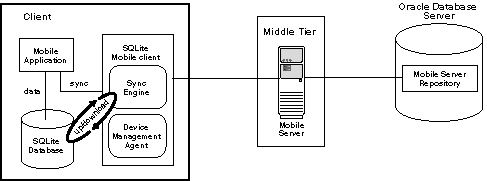| Oracle® Database Lite SQLite Mobile Client Guide Release 10.3 Part Number E16214-01 |
|
|
View PDF |
| Oracle® Database Lite SQLite Mobile Client Guide Release 10.3 Part Number E16214-01 |
|
|
View PDF |
The following sections describe the SQLite Mobile client:
The SQLite database is a small, compact, and self-contained database available on multiple platforms and available to the public. It has a small footprint and is easy to install and administer. In addition, many devices have the SQLite database already installed, including Android and Blackberry devices.
Oracle Database Lite offers you the ability to synchronize the data entered in one or more SQLite databases to a back-end Oracle database with the SQLite Mobile client. The SQLite database is independent from the SQLite Mobile client. The SQLite Mobile client provides the ability to synchronize the data in SQLite databases with the Sync Engine. This book describes how to configure, manage and implement synchronization using the Sync Engine. It does not discuss how to configure, manage or use the SQLite database. For information on the SQLite database itself, see http://www.sqlite.org/.
The SQLite database does not provide the same SQL functionality as Oracle databases. Thus, refer to http://www.sqlite.org/ for a full list of what is supported.
The SQLite Mobile client can be installed on the following platforms: Linux, Windows (Win32), WinCE, Android and Blackberry platforms. Device management is supported on Win32, WinCE and Linux platforms. The Sync Engine supports both automatic and manual synchronization for SQLite databases. However, without device management support, remote device management and automatic synchronization is not supported on Android and Blackberry platforms.
As shown in Figure 1-1, when both the SQLite database and the SQLite Mobile client are installed, the mobile device has the following components:
SQLite database—A small database that is installed independently.
SQLite Mobile client—When you install the SQLite Mobile client, the following components are provided:
Sync Engine—Enables manual or automatic synchronization. Manual synchronization is initiated by the mobile application. Automatic synchronization can be enabled only on the Win32, WinCE, and Linux platforms.
The Sync Engine interacts with the SQLite database to upload and download data in conjunction with the Mobile Server to synchronize the data with the Oracle database.
Device Manager Agent (DM Agent)—The DM Agent is only installed on Win32, WinCE, and Linux. The Mobile Server uses the DM Agent to send commands to the device and manage the mobile device. The Blackberry and Android platforms cannot be managed by the Mobile Server, so the DM Agent is not installed on these devices.
Mobile application—Interacts with the SQLite database to manage the data. Interacts with the Sync Engine to initiate a manual synchronization.
Figure 1-1 Architecture for Client with SQLite Database and SQLite Mobile Client
